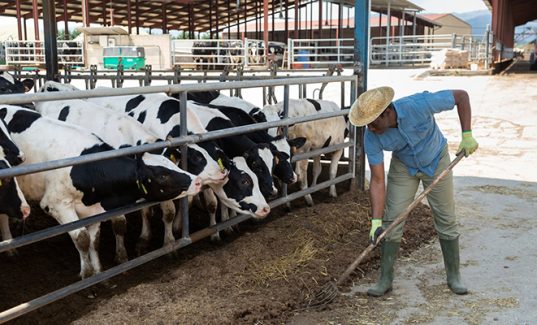Cash cheese prices slipped last week but the spread narrowed a little. The blocks closed Friday at $1.54 per pound, down 7 1/2-cents on the week and the fourth week in a row of decline, but were still 2 3/4-cents above a year ago.
History was made Monday as the cheese moved to the electronic spot call at the CME. The blocks lost a penny and a half but were unchanged Tuesday, holding at $1.5250, the lowest spot price since May 4, 2017.
The barrels rolled to $1.3375 last Tuesday, the lowest price since May 16, 2016, but rallied and finished Friday at $1.37, down just a penny on the week and 16 1/2-cents below a year ago.
Thirteen cars of block traded hands last week at the CME and a whopping 63 of barrel. The last time barrel volume was over 60 loads was in September 2000, according to FC Stone.
The barrels inched a quarter-cent lower Monday and stayed there Tuesday, at $1.3675, a still too-high 15 3/4-cents below the blocks.
More milk will be shifting from the carton to the cheese vat as schools close for the summer but temperatures may, pardon the pun, temper milk output per cow.
Milk continues to be available for cheese producers in the Midwest, according to Dairy Market News.
“However, cheesemakers report the flush milk availability of previous weeks has noticeably decreased,” DMN says. Cheese production has edged back. Some producers are trying to manage heavy inventories, and “some contacts suggest export sales, which are scheduled for future shipment dates, have not been accounted for, thus cheese inventories are not as heavy as widely believed.”
Central cheese producers report varied sales activity but the large block-to-barrel price variance “is at loggerheads with a stable market, according to Central cheese contacts,” says DMN.
Western cheesemakers report continued strong production as milk supplies are readily available. Contacts describe demand as good, but not great. Export inquiries seem to vacillate along with the variance between current U.S. market prices and international prices. Inventories are long.
Cash butter continued to roller coaster last week but closed 3 cents higher, at $2.59 per pound, 24 1/2-cents above a year ago, with 17 cars sold last week.
The spot was up 3 1/2-cents Monday and inched a quarter-cent higher Tuesday, to $2.6250.
“Butter’s performance, in retail and food service, is outperforming previous years,” says DMN, “and continues to keep production facilities busy.” Butter makers are reportedly “attempting to focus production on late summer-early fall expectations, whenever not fulfilling current orders,” but cream supplies are tightening.
The butter market tone is healthy, and some contacts are bullish for the near term. Contacts suggest that “global milkfat demand continues to bolster domestic butter prices.”
“Demand for butterfat continues to be a primary driving force within the dairy industry, and Western butter output is also strong and focused mostly on putting away bulk butter for needs later in the year.
Inventories are “fairly heavy,” but contacts suggest that stocks are “either committed or manufacturers are willing to hold butter supplies until peak butter demand season in the fall and early winter.”
Cash Grade A nonfat dry milk finished Friday at 84 3/4-cents per pound, down 6 1/4-cents on the week and 5 1/4-cents below a year ago, on 11 cars sold.
The powder was down a quarter-cent both Monday and Tuesday, slipping to 84 1/4-cents per pound.
FC Stone reports that the EU Commission sold 100 tons of skim milk powder out of Intervention in their latest tender. That, plus slower exports to Mexico and expected increases in global milk output contributed to the weaker CME price.
Federal Class I up
The July federal order Class I base milk price is $16.59 per hundredweight, up $1.28 from June, $2.89 above July 2016, and equates to $1.43 per gallon, up from $1.32 in May and $1.18 a year ago. It is the highest Class I base since March 2017 and the highest July Class I since 2014.
The 2017 average now stands at $16.32, up from $13.96 at this time a year ago and compares to $16.34 in 2015.
Cows retiring
More dairy cows are retiring from the dairy business. USDA’s latest Livestock Slaughter report shows May culling was up from April and 2016. An estimated 237,200 head were slaughtered under federal inspection, up 9,100 head from April and 22,600 head above May 2016. Culling in the first five months of 2017 totaled 1.26 million head, up 33,000 from a year ago or 2.7 percent.
Lots of stocks
The nation’s coolers are busting at the seams, at least on cheese. May butter stocks hit 313.6 million pounds, up 21.3 million pounds or 7.3 percent from April but 11.4 million pounds or 3.5 percent below a year ago.
American cheese, at 847 million pounds, was up 13.5 million pounds or 1.6 percent from April and 89.5 million pounds or 11.8 percent above a year ago.
The total cheese inventory stood at a record 1.34 billion pounds, up 7.6 million pounds or 0.6 percent from April and 91 million pounds or 7 percent above a year ago.
Source: Capital Press




